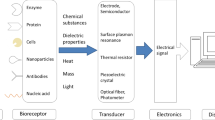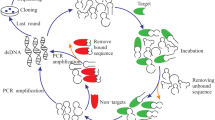Access this chapter
Tax calculation will be finalised at checkout
Purchases are for personal use only
Similar content being viewed by others
References
Gerber MA, Shulman ST (2004) Rapid diagnosis of pharyngitis caused by group A streptococci. Clin Microbiol Rev 17(3):571–580 (table of contents)
Alocilja EC, Radke SM (2003) Market analysis of biosensors for food safety. Biosens Bioelectron 18(5–6):841–846
Lazcka O, Del Campo FJ, Munoz FX (2007) Pathogen detection: a perspective of traditional methods and biosensors. Biosens Bioelectron 22(7):1205–1217
Kostrzynska M, Leung KT, Lee H, Trevors JT (2002) Green fluorescent protein-based biosensor for detecting SOS-inducing activity of genotoxic compounds. J Microbiol Methods 48(1):43–51
Subrahmanyam S, Piletsky SA, Turner AP (2002) Application of natural receptors in sensors and assays. Anal Chem 74(16):3942–3951
Labib M, Hedström M, Amin M, Mattiasson B (2009a) A capacitive biosensor for detection of staphylococcal enterotoxin B. Anal Bioanal Chem 393(5):1539–1544
Labib M, Hedström M, Amin M, Mattiasson B (2009b) A capacitive immunosensor for detection of cholera toxin. Anal Chim Acta 634(2):255–261
Labib M, Hedström M, Amin M, Mattiasson B (2009c) A multipurpose capacitive biosensor for assay and quality control of human immunoglobulin G. Biotechnol Bioeng 104(2):312–320
Labib M, Hedström M, Amin M, Mattiasson B (2010a) Competitive capacitive biosensing technique (CCBT): a novel technique for monitoring low molecular mass analytes using glucose assay as a model study. Anal Bioanal Chem 397(3):1217–1224
Labib M, Hedström M, Amin M, Mattiasson B (2010b) A novel competitive capacitive glucose biosensor based on concanavalin A-labeled nanogold colloids assembled on a polytyramine-modified gold electrode. Anal Chim Acta 659(1–2):194–200
Labib M, Martić S, Shipman PO, Kraatz HB (2011a) Electrochemical analysis of HIV-1 reverse transcriptase serum level: exploiting protein binding to a functionalized nanostructured surface. Talanta 85(1):770–778
Labib M, Shipman PO, Martić S, Kraatz H-B (2011b) A bioorganometallic approach for rapid electrochemical analysis of human immunodeficiency virus type-1 reverse transcriptase in serum. Electrochimica Acta 56(14):5122–5128
Labib M, Shipman PO, Martić S, Kraatz HB (2011c) Towards an early diagnosis of HIV infection: an electrochemical approach for detection of HIV-1 reverse transcriptase enzyme. Analyst 136(4):708–715
Martić S, Labib M, Kraatz HB (2011a) Electrochemical investigations of sarcoma-related protein kinase inhibition. Electrochimica Acta 56:10676–10682
Martić S, Labib M, Kraatz HB (2011b) On chip electrochemical detection of sarcoma protein kinase and HIV-1 reverse transcriptase. Talanta 85(5):2430–2436
Du X, Sasaki S, Nakamura H, Karube I (2001) The determination of DNA based on light-scattering of a complex formed with histone. Talanta 55(1):93–98
Uludag Y, Piletsky SA, Turner AP, Cooper MA (2007) Piezoelectric sensors based on molecular imprinted polymers for detection of low molecular mass analytes. FEBS J 274(21):5471–5480
Labib M, Zamay AS, Muharemagic D, Chechik AV, Bell JC, Berezovski MV (2012a) Aptamer-based viability impedimetric sensor for viruses. Anal Chem 84(4):1813–1816
Labib M, Zamay AS, Muharemagic D, Chechik AV, Bell JC, Berezovski MV (2012b) Electrochemical differentiation of epitope-specific aptamers. Anal Chem 84(5):2548–2556
Berezovski M, Musheev M, Drabovich A, Krylov SN (2006) Non-SELEX selection of aptamers. J Am Chem Soc 128(5):1410–1411
Berezovski MV, Lechmann M, Musheev MU, Mak TW, Krylov SN (2008) Aptamer-facilitated biomarker discovery (AptaBiD). J Am Chem Soc 130(28):9137–9143
White RR, Sullenger BA, Rusconi CP (2000) Developing aptamers into therapeutics. J Clin Invest 106(8):929–934
Proske D, Blank M, Buhmann R, Resch A (2005) Aptamers–basic research, drug development, and clinical applications. Appl Microbiol Biotechnol 69(4):367–374
BCC-Research (2010) Nucleic acid aptamers for diagnostics and therapeutics: global markets. BCC Research, Wellesley, MA
Lee JO, So HM, Jeon EK, Chang H, Won K, Kim YH (2008) Aptamers as molecular recognition elements for electrical nanobiosensors. Anal Bioanal Chem 390(4):1023–1032
Crespo GA, Macho S, Rius FX (2008) Ion-selective electrodes using carbon nanotubes as ion-to-electron transducers. Anal Chem 80(4):1316–1322
Dai H (2002) Carbon nanotubes: synthesis, integration, and properties. Acc Chem Res 35(12):1035–1044
Crespo GA, Macho S, Bobacka J, Rius FX (2009) Transduction mechanism of carbon nanotubes in solid-contact ion-selective electrodes. Anal Chem 81(2):676–681
Zheng M, Jagota A, Strano MS, Santos AP, Barone P, Chou SG, Diner BA, Dresselhaus MS, McLean RS, Onoa GB, Samsonidze GG, Semke ED, Usrey M, Walls DJ (2003) Structure-based carbon nanotube sorting by sequence-dependent DNA assembly. Science 302(5650):1545–1548
Star A, Tu E, Niemann J, Gabriel JC, Joiner CS, Valcke C (2006) Label-free detection of DNA hybridization using carbon nanotube network field-effect transistors. Proc Natl Acad Sci USA 103(4):921–926
So HM, Park DW, Jeon EK, Kim YH, Kim BS, Lee CK, Choi SY, Kim SC, Chang H, Lee JO (2008) Detection and titer estimation of Escherichia coli using aptamer-functionalized single-walled carbon-nanotube field-effect transistors. Small 4(2):197–201
Rahal EA, Kazzi N, Nassar FJ, Matar GM (2012) Escherichia coli O157: H7-Clinical aspects and novel treatment approaches. Front Cell Infect Microbiol 2:138
Pan Q, Zhang XL, Wu HY, He PW, Wang F, Zhang MS, Hu JM, Xia B, Wu J (2005) Aptamers that preferentially bind type IVB pili and inhibit human monocytic-cell invasion by Salmonella enterica serovar typhi. Antimicrob Agents Chemother 49(10):4052–4060
Zelada-Guillen GA, Riu J, Duzgun A, Rius FX (2009) Immediate detection of living bacteria at ultralow concentrations using a carbon nanotube based potentiometric aptasensor. Angew Chem Int Ed Engl 48(40):7334–7337
Chiu CH, Tang P, Chu C, Hu S, Bao Q, Yu J, Chou YY, Wang HS, Lee YS (2005) The genome sequence of Salmonella enterica serovar Choleraesuis, a highly invasive and resistant zoonotic pathogen. Nucleic Acids Res 33(5):1690–1698
Wong SS, Joselevich E, Woolley AT, Cheung CL, Lieber CM (1998) Covalently functionalized nanotubes as nanometre-sized probes in chemistry and biology. Nature 394(6688):52–55
Zelada-Guillen GA, Bhosale SV, Riu J, Rius FX (2010) Real-time potentiometric detection of bacteria in complex samples. Anal Chem 82(22):9254–9260
Decludt B, Bouvet P, Mariani-Kurkdjian P, Grimont F, Grimont PA, Hubert B, Loirat C (2000) Haemolytic uraemic syndrome and Shiga toxin-producing Escherichia coli infection in children in France. The Societe de Nephrologie Pediatrique. Epidemiol Infect 124(2):215–220
Zelada-Guillen GA, Sebastian-Avila JL, Blondeau P, Riu J, Rius FX (2012) Label-free detection of Staphylococcus aureus in skin using real-time potentiometric biosensors based on carbon nanotubes and aptamers. Biosens Bioelectron 31(1):226–232
Cao X, Li S, Chen L, Ding H, Xu H, Huang Y, Li J, Liu N, Cao W, Zhu Y, Shen B, Shao N (2009) Combining use of a panel of ssDNA aptamers in the detection of Staphylococcus aureus. Nucleic Acids Res 37(14):4621–4628
Chen RJ, Zhang Y, Wang D, Dai H (2001) Noncovalent sidewall functionalization of single-walled carbon nanotubes for protein immobilization. J Am Chem Soc 123(16):3838–3839
Bogomolova A, Komarova E, Reber K, Gerasimov T, Yavuz O, Bhatt S, Aldissi M (2009) Challenges of electrochemical impedance spectroscopy in protein biosensing. Anal Chem 81(10):3944–3949
Labib M, Zamay AS, Kolovskaya OS, Reshetneva IT, Zamay GS, Kibbee RJ, Sattar SA, Zamay TN, Berezovski MV (2012c) Aptamer-based impedimetric sensor for bacterial typing. Anal Chem 84(19):8114–8117
Labib M, Zamay AS, Kolovskaya OS, Reshetneva IT, Zamay GS, Kibbee RJ, Sattar SA, Zamay TN, Berezovski MV (2012d) Aptamer-based viability impedimetric sensor for bacteria. Anal Chem 84(21):8966–8969
Arnon SS, Schechter R, Inglesby TV, Henderson DA, Bartlett JG, Ascher MS, Eitzen E, Fine AD, Hauer J, Layton M, Lillibridge S, Osterholm MT, O’Toole T, Parker G, Perl TM, Russell PK, Swerdlow DL, Tonat K (2001) Botulinum toxin as a biological weapon: medical and public health management. JAMA 285(8):1059–1070
Wei F, Ho CM (2009) Aptamer-based electrochemical biosensor for Botulinum neurotoxin. Anal Bioanal Chem 393(8):1943–1948
Wei F, Wang J, Liao W, Zimmermann BG, Wong DT, Ho CM (2008) Electrochemical detection of low-copy number salivary RNA based on specific signal amplification with a hairpin probe. Nucleic Acids Res 36(11):e65
Breitholtz A, Olsen M, Dahlback A, Hult K (1991) Plasma ochratoxin A levels in three Swedish populations surveyed using an ion-pair HPLC technique. Food Addit Contam 8(2):183–192
Kuang H, Chen W, Xu D, Xu L, Zhu Y, Liu L, Chu H, Peng C, Xu C, Zhu S (2010) Fabricated aptamer-based electrochemical “signal-off” sensor of ochratoxin A. Biosens Bioelectron 26(2):710–716
Pearson L, Mihali T, Moffitt M, Kellmann R, Neilan B (2010) On the chemistry, toxicology and genetics of the cyanobacterial toxins, microcystin, nodularin, saxitoxin and cylindrospermopsin. Mar Drugs 8(5):1650–1680
Ng A, Chinnappan R, Eissa S, Liu H, Tlili C, Zourob M (2012) Selection, characterization, and biosensing application of high affinity congener-specific microcystin-targeting aptamers. Environ Sci Technol 46(19):10697–10703
Preston A, Mandrell RE, Gibson BW, Apicella MA (1996) The lipooligosaccharides of pathogenic gram-negative bacteria. Crit Rev Microbiol 22(3):139–180
Kim SE, Su W, Cho M, Lee Y, Choe WS (2012) Harnessing aptamers for electrochemical detection of endotoxin. Anal Biochem 424(1):12–20
Damon I (2007) Poxviridae and their replication. In: Fields BN, Knipe DM et al (eds) Fields virology. Raven Press Ltd., New York, pp 2079–2081
Whitley RJ (2003) Smallpox: a potential agent of bioterrorism. Antiviral Res 57(1–2):7–12
Mead D, Ramberg F, Besselsen D, Mare C (2000) Transmission of vesicular stomatitis virus from infected to non-infected black flies co-feeding on non viremic deer mice. Science 287:486–487
Labib M, Zamay AS, Muharemagic D, Chechik A, Bell JC, Berezovski MV (2012e) Electrochemical sensing of aptamer-facilitated virus immunoshielding. Anal Chem 84(3):1677–1686
Sakudo A, Ikuta K (2008) Efficient capture of infectious H5 avian influenza virus utilizing magnetic beads coated with anionic polymer. Biochem Biophys Res Commun 377(1):85–88
Qi C, Tian XS, Chen S, Yan JH, Cao Z, Tian KG, Gao GF, Jin G (2010) Detection of avian influenza virus subtype H5 using a biosensor based on imaging ellipsometry. Biosens Bioelectron 25(6):1530–1534
Jenison RD, Gill SC, Pardi A, Polisky B (1994) High-resolution molecular discrimination by RNA. Science 263(5152):1425–1429
Sassanfar M, Szostak JW (1993) An RNA motif that binds ATP. Nature 364(6437):550–553
Kukol A, Li P, Estrela P, Ko-Ferrigno P, Migliorato P (2008) Label-free electrical detection of DNA hybridization for the example of influenza virus gene sequences. Anal Biochem 374(1):143–153
Zhu X, Ai S, Chen Q, Yin H, Xu J (2009) Label-free electrochemical detection of Avian Influenza Virus genotype utilizing multi-walled carbon nanotubes-cobalt phthalocyanine-PAMAM nanocomposite modified glassy carbon electrode. Electrochem Commun 11:1543–1546
Shen L, Chen Z, Li Y, He S, Xie S, Xu X, Liang Z, Meng X, Li Q, Zhu Z, Li M, Le XC, Shao Y (2008) Electrochemical DNAzyme sensor for lead based on amplification of DNA-Au bio-bar codes. Anal Chem 80(16):6323–6328
Liu X, Cheng Z, Fan H, Ai S, Han R (2011) Electrochemical detection of avian influenza virus H5N1 gene sequence using a DNA aptamer immobilized onto a hybrid nanomaterial-modified electrode. Electrochimica Acta 56:6266–6270
Lai WA, Lin CH, Yang YS, Lu MS (2012) Ultrasensitive and label-free detection of pathogenic avian influenza DNA by using CMOS impedimetric sensors. Biosens Bioelectron 35(1):456–460
June GA, Sherrod PS, Hammack TS, Amaguana RM, Andrews WH (1996) Relative effectiveness of selenite cystine broth, tetrathionate broth, and rappaport-vassiliadis medium for recovery of Salmonella spp. from raw flesh, highly contaminated foods, and poultry feed: collaborative study. J AOAC Int 79(6):1307–1323
Edwards RA, Olsen GJ, Maloy SR (2002) Comparative genomics of closely related salmonellae. Trends Microbiol 10(2):94–99
Eyigor A, Carli KT, Unal CB (2002) Implementation of real-time PCR to tetrathionate broth enrichment step of Salmonella detection in poultry. Lett Appl Microbiol 34(1):37–41
Condit RC, Moussatche N, Traktman P (2006) In a nutshell: structure and assembly of the vaccinia virion. Adv Virus Res 66:31–124
Wolffe EJ, Vijaya S, Moss B (1995) A myristylated membrane protein encoded by the vaccinia virus L1R open reading frame is the target of potent neutralizing monoclonal antibodies. Virology 211(1):53–63
Rodriguez JF, Janeczko R, Esteban M (1985) Isolation and characterization of neutralizing monoclonal antibodies to vaccinia virus. J Virol 56(2):482–488
Hsiao JC, Chung CS, Chang W (1999) Vaccinia virus envelope D8L protein binds to cell surface chondroitin sulfate and mediates the adsorption of intracellular mature virions to cells. J Virol 73(10):8750–8761
Davies DH, McCausland MM, Valdez C, Huynh D, Hernandez JE, Mu Y, Hirst S, Villarreal L, Felgner PL, Crotty S (2005) Vaccinia virus H3L envelope protein is a major target of neutralizing antibodies in humans and elicits protection against lethal challenge in mice. J Virol 79(18):11724–11733
Nelson GE, Sisler JR, Chandran D, Moss B (2008) Vaccinia virus entry/fusion complex subunit A28 is a target of neutralizing and protective antibodies. Virology 380(2):394–401
Hooper JW, Custer DM, Schmaljohn CS, Schmaljohn AL (2000) DNA vaccination with vaccinia virus L1R and A33R genes protects mice against a lethal poxvirus challenge. Virology 266(2):329–339
Cruz-Aguado JA, Penner G (2008) Determination of ochratoxin a with a DNA aptamer. J Agric Food Chem 56(22):10456–10461
Czerwinski JD, Hovan SC, Mascotti DP (2005) Quantitative nonisotopic nitrocellulose filter binding assays: bacterial manganese superoxide dismutase-DNA interactions. Anal Biochem 336(2):300–304
Tahiri-Alaoui A, Frigotto L, Manville N, Ibrahim J, Romby P, James W (2002) High affinity nucleic acid aptamers for streptavidin incorporated into bi-specific capture ligands. Nucleic Acids Res 30(10):e45
Mendonsa SD, Bowser MT (2004) In vitro evolution of functional DNA using capillary electrophoresis. J Am Chem Soc 126(1):20–21
Michaud M, Jourdan E, Villet A, Ravel A, Grosset C, Peyrin E (2003) A DNA aptamer as a new target-specific chiral selector for HPLC. J Am Chem Soc 125(28):8672–8679
Muller M, Weigand JE, Weichenrieder O, Suess B (2006) Thermodynamic characterization of an engineered tetracycline-binding riboswitch. Nucleic Acids Res 34(9):2607–2617
del Toro M, Gargallo R, Eritja R, Jaumot J (2008) Study of the interaction between the G-quadruplex-forming thrombin-binding aptamer and the porphyrin 5,10,15,20-tetrakis-(N-methyl-4-pyridyl)-21,23H-porphyrin tetratosylate. Anal Biochem 379(1):8–15
Wang J, Lv R, Xu J, Xu D, Chen H (2008) Characterizing the interaction between aptamers and human IgE by use of surface plasmon resonance. Anal Bioanal Chem 390(4):1059–1065
Zhang WY, Zhang W, Liu Z, Li C, Zhu Z, Yang CJ (2012) Highly parallel single-molecule amplification approach based on agarose droplet polymerase chain reaction for efficient and cost-effective aptamer selection. Anal Chem 84(1):350–355
Stojdl DF, Lichty B, Knowles S, Marius R, Atkins H, Sonenberg N, Bell JC (2000) Exploiting tumor-specific defects in the interferon pathway with a previously unknown oncolytic virus. Nat Med 6(7):821–825
Rose NF, Marx PA, Luckay A, Nixon DF, Moretto WJ, Donahoe SM, Montefiori D, Roberts A, Buonocore L, Rose JK (2001) An effective AIDS vaccine based on live attenuated vesicular stomatitis virus recombinants. Cell 106(5):539–549
Fisher KD, Stallwood Y, Green NK, Ulbrich K, Mautner V, Seymour LW (2001) Polymer-coated adenovirus permits efficient retargeting and evades neutralising antibodies. Gene Ther 8(5):341–348
Doronin K, Shashkova EV, May SM, Hofherr SE, Barry MA (2009) Chemical modification with high molecular weight polyethylene glycol reduces transduction of hepatocytes and increases efficacy of intravenously delivered oncolytic adenovirus. Hum Gene Ther 20(9):975–988
Ong HT, Hasegawa K, Dietz AB, Russell SJ, Peng KW (2007) Evaluation of T cells as carriers for systemic measles virotherapy in the presence of antiviral antibodies. Gene Ther 14(4):324–333
Goebel SJ, Johnson GP, Perkus ME, Davis SW, Winslow JP, Paoletti E (1990) The complete DNA sequence of vaccinia virus. Virology 179(1):247–266
Yu YA, Shabahang S, Timiryasova TM, Zhang Q, Beltz R, Gentschev I, Goebel W, Szalay AA (2004) Visualization of tumors and metastases in live animals with bacteria and vaccinia virus encoding light-emitting proteins. Nat Biotechnol 22(3):313–320
Fabris L, Dante M, Braun G, Lee SJ, Reich NO, Moskovits M, Nguyen TQ, Bazan GC (2007) A heterogeneous PNA-based SERS method for DNA detection. J Am Chem Soc 129(19):6086–6087
Borghesi L, Milcarek C (2006) From B cell to plasma cell: regulation of V(D)J recombination and antibody secretion. Immunol Res 36(1–3):27–32
Muharemagic D, Labib M, Ghobadloo SM, Zamay AS, Bell JC, Berezovski MV (2012) Anti-fab aptamers for shielding virus from neutralizing antibodies. J Am Chem Soc 134(41):17168–17177
Author information
Authors and Affiliations
Corresponding author
Editor information
Editors and Affiliations
Rights and permissions
Copyright information
© 2013 Springer-Verlag Berlin Heidelberg
About this chapter
Cite this chapter
Labib, M., Berezovski, M.V. (2013). Electrochemical Aptasensors for Microbial and Viral Pathogens. In: Gu, M., Kim, HS. (eds) Biosensors Based on Aptamers and Enzymes. Advances in Biochemical Engineering/Biotechnology, vol 140. Springer, Berlin, Heidelberg. https://doi.org/10.1007/10_2013_229
Download citation
DOI: https://doi.org/10.1007/10_2013_229
Published:
Publisher Name: Springer, Berlin, Heidelberg
Print ISBN: 978-3-642-54142-1
Online ISBN: 978-3-642-54143-8
eBook Packages: Chemistry and Materials ScienceChemistry and Material Science (R0)




